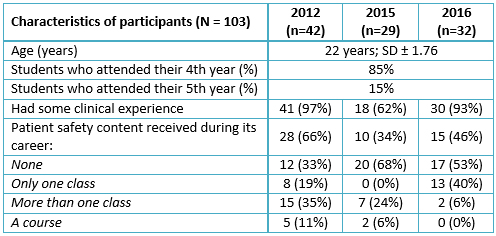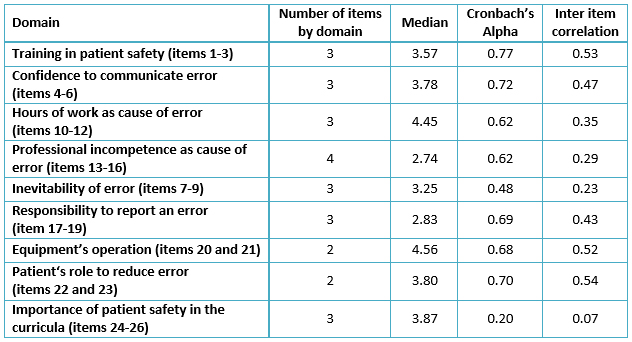Research papers
← vista completaPublished on December 20, 2016 | http://doi.org/10.5867/medwave.2016.11.6809
Knowledge, beliefs and attitudes report on patient care and safety in undergraduate students: validating the modified APSQ-III questionnaire
Reporte de conocimientos, creencias y actitudes en calidad de atención y seguridad del paciente en alumnos de pregrado: validando el cuestionario APSQ-III modificado
Abstract
INTRODUCTION Patient safety aims to achieve healthcare free of damage. The World Health Organization indicates that this objective is achieved through communication, analysis, and prevention of adverse events in patients. Organizational culture has been identified as one of the main factors for interventions aimed to reduce medical errors; and an essential component of safety culture is the attitude of health professionals towards medical error. Attitudes can be improved through appropriate education in biomedical careers but its inclusion in Argentina is scarce. The Attitudes Questionnaire for Patient Safety, measures knowledge, beliefs, and attitudes about patient safety and could be a useful tool in our country.
OBJECTIVES To validate the modified attitudes for patient safety questionnaire to measure knowledges, beliefs, and attitudes of medical students at CEMIC University Institute. To describe the level of knowledges, beliefs, and attitudes in patient safety of medical students at CEMIC University Institute in 2012, 2015 and 2016.
METHODS Design: descriptive study. Scope: Exploratory. Setting: the CEMIC University Institute in Buenos Aires, Argentina. Population: medical students of 4th and 5th year. Sampling: a sample size of 100 participants was estimated to derive meaningful estimates as per a Cronbach's alpha> 0.60.
RESULTS The reliability of the instrument (internal consistency) by Cronbach's alpha showed an overall correlation of 0.695. Suitable Cronbach's alpha values were obtained in all categories, except in two: importance of patient safety in the curriculum and the inevitability of error. The responses on knowledge, attitudes and perceptions about patient safety in the three cohorts showed that 57% of students believe they understand concepts about patient safety, 53% consider their training prepares them to understand the cause of medical errors, only 59% believe that human error is inevitable and 98% believe that real professionals do not make mistakes. Lastly, 64% believe that this knowledge is only acquired from clinical experience.
CONCLUSION This study shows that the APSQ-III modified survey is valid and could be used in Argentina and the region to measure the impact of incorporating patient safety topics in the medical curriculum.
Introduction
Patient safety aims to achieve harmless health care. The conceptual framework of the World Health Organization (WHO) [1] indicates that this goal is achieved through communication, analysis and prevention of patient’s adverse events. The frequency of adverse events and the consequence of errors in health care affects more than 10% of hospitalized patients [2],[3],[4].
Organizational culture has been identified as one of the main factors for the success of interventions to reduce medical errors and to improve patient safety [2]. An essential component of a safety culture is the attitude of healthcare professionals towards medical error. Attitudes can be improved through appropriate education in biomedical careers [5],[6]. The World Health Organization recommends the inclusion of these contents [7] in the curricula of biomedical careers. Their inclusion in Argentinian programs is scarce [8],[9].
Education programs should be evaluated to establish their impact. The Attitudes for Patient Safety Questionnaire (APSQ III) [10] measures knowledge, beliefs, and attitudes about patient safety.
This study sought to answer if it is valid to use the modified APSQ III instrument for the measurement of knowledge, beliefs and attitudes in medical students of the CEMIC University Institute (Instituto Universitario Centro de Educación Médica e Investigaciones Clínicas), in patient safety and to describe their level of knowledge, beliefs and attitudes in 2012, 2015 and 2016.
Methods
For this study, a descriptive, exploratory study was carried out at CEMIC University Institute (IUC), in Buenos Aires, Argentina. The subjects of the study were fourth and fifth year medical students. A sample size of 100 participants was estimated necessary to obtain significant estimates according to Cronbach's alpha> 0.6 [11].
The inclusion criteria were to be a medical student at the CEMIC University Institute attending the fourth or fifth year. All the students of the population could be included, without exclusion criteria.
The study was carried out in two phases, the first phase was the modification of the British questionnaire APSQ-III of 26 items [10]. The APSQ III questions are distributed in nine categories: training received in patient safety, confidence in communication of error, working hours as a cause of error, inevitability of error, professional incompetence as a cause of error, responsibility in communication, functioning of the team, commitment of the patient in reducing errors and the importance of patient safety in the curricula. The tool is useful to understand knowledge, beliefs and attitudes toward patient safety in biomedical career students, and for comparing the effectiveness of including patient safety in curricula. It was adapted in the year 2014 [12] with a Likert scale of seven items, similar to the original instrument.
To carry out this study, through the consensus of experts and literature review [13] we decided to readjust the Likert scale to five points (strongly disagree to strongly agree), maintaining the original statements of the questions. For those questions posed from a negative orientation, the values of the answers were established conversely.
In the second phase of implementation, the questionnaire was delivered to medical students in 2012, 2015 and 2016, with a response rate of 100%.
The variables of interest were attitudes, beliefs and knowledge. As a conceptual definition, Rokeach [14] defines attitude as a set of predispositions for action (beliefs, valuations, modes of perceptions, etcetera) that is organized and related to an object or situation. Thus, attitude has three components: a cognitive one that includes beliefs and opinions about facts; an affective one that gives account of feelings, positive or negative emotion related to the object; and an action component, which refers to the state of predisposition or tendency to act in a certain way. The set of these three components results in the predisposition.
As an operational definition, according to the original questionnaire authors [10], a positive attitude towards patient safety is one that considers the system, not the individual as the cause of error. Therefore, this person recognizes the importance of learning about patient safety (items 24, 25 and 26), sees the patients with an important role in their health (items 22 and 23), is confident to report incidents (item 4- 6, 17-19) and recognizes the influence of specific circumstances related to patient safety (item 7-16).
Surveys were collected and transcribed into an on-line form for its analysis.
The results were analyzed with descriptive statistics adequate to the nature of the variable and its distribution. A univariate analysis of age, clinical experience, content in patient safety received during a student’s career and year the student was attending, was performed.
The reliability (internal consistency) of the instrument was explored using Cronbach's alpha. Measurement of reliability using the Cronbach's alpha assumes that the items (measured on a Likert scale) measure the same construct and are highly correlated. The closer the alpha value is to 1, the greater the internal consistency of the items analyzed. We also analyzed the answers about knowledge, attitudes and perceptions about patient safety in the three cohorts of medical students, described as percentages.
The collected data was evaluated using STATA 13.0
All included students received information about the motivation to do the study. The study was approved by the CEMIC Bioethics Committee to be conducted without written consent. The participation of the interviewees was voluntary and the anonymity and confidentiality of their answers were ensured through surveys issued without registration of personal data.
Results
In the year 2012, 42 medical students completed the questionnaire, 29 students in 2015 and 32 students in 2016. Eighty five percent of all students were attending their fourth year (of a total of six years), and the rest were attending their fifth year. The survey did not include a question about the gender of the respondents. The response rate was 100%.
 Full size
Full size The reliability (internal consistency) of the instrument using Cronbach's alpha showed an overall correlation of 0.695.
The average relationship between items, measures the internal consistency of the instrument. The average relationship between items is shown in Table 2.
 Full size
Full size Responses about knowledge, attitudes, and perceptions of patient safety showed that 57% believed they understood patient safety concepts, only 53% felt that their training prepared them to understand the cause of error. Seventy-four percent feels more comfortable communicating their own mistakes than other people's mistakes and only 59% considers human error as inevitable. Ninety-eight percent believes that a true professional does not make mistakes and 69% believes that medical errors are a sign of incompetence. Only 52% of students considers that the patient has an important role in error prevention, although 85% believe that encouraging patient participation in their care can reduce the risk of medical error. Ninety-nine percent believe that patient safety is a priority in the curricula, although 64% believe that this knowledge is acquired only from clinical experience, not through formal learning.
Discussion
Based on these results we have been able to validate the modified APSQ-III questionnaire. There are a few validated instruments available for measuring medical student attitudes to patient safety, and none has been validated in our setting, except for the pilot test of Lamponi et al [12]. In all but two categories, adequate Cronbach alpha values were obtained, similar to those published by Carruthers et al [10] while validating the original instrument. The low value of Cronbach's alpha coefficient in the category of importance of patient safety in the curricula and inevitability of error would indicate that some items do not identify attitudes in the same way as others [15], which implies that the formulation of items included in this category should be reconsidered.
Finally, it should be noted that these differences could also be due to an immature culture of patient safety in our environment, which makes it difficult for medical students to recognize error.
Although CEMIC University Institute medical students receive isolated contents of patient safety and quality of care throughout their career, exploratory findings from this study show inadequate concepts of knowledge, beliefs, and attitudes regarding patient safety in medical students of this university institute.
The limitations of this study were the small sample size and the lack of data for years 2013 and 2014. In light of these findings, we understand that the obtained response rate compensates for the aspects required for validation and suggests that the questionnaire is feasible to respond.
Conclusions
We have been able to validate the modified APSQ-III questionnaire. This instrument can be used, both locally and in the region, to measure the impact of including contents related to this discipline.
This instrument may also foster future research on the impact of the inclusion of these contents in educational plans of undergraduate biomedical careers.
Notes
From the editor
The authors originally submitted this article in Spanish and subsequently translated it into English. The Journal has not copyedited this version.
Ethical considerations
The Journal is aware that the ethical scientific committee of the Center for Medical Education and Clinical Research "Norberto Quirno" was informed about this study and its possible publication in a biomedical dissemination journal.
Conflicts of interest
The authors completed the ICMJE conflict of interest declaration form, translated to Spanish by Medwave, and declare not having received funding for the preparation of this report, not having any financial relationships with organizations that could have interests in the published article in the last three years, and not having other relations or activities that might influence the article´s content. Forms can be requested to the responsible author or the editorial direction of the Journal.
Financing
This research was self-financed by the main researcher.

